Old and newer King James Versions and other translations #6 Revisions of revisions
With the years some english people came to believe that God prepared another world language. Though Spanish and Chinese or Sinitic languages (Sino-Tibetan language family: Mandarin, Wu, Min, Gan, Hakka, Xiang, and Cantonese sharing the common literary language wenyan) are bigger world languages, they do think that
English is that world language. And one reason is because of the preservation of the word. {Why should God’s Word be restricted to English?}
Because often those people not knowing enough the other languages and not able to compare them with the original Greek, Aramaic and Hebrew language, they like to place their own language in the first place, not seeing that in many of Bible editions in their language words were not always translated exactly or not seeing that certain words where changed in names in place to taking it for the things they meant in the original language.
In the past some English scholars knew that sometimes the Hebrew and Greek way of saying things could be too complicated for some English speaking people, of which approximately 330 to 360 million have that language as their first language. They did find God His Word so important they wanted all people, young and old, educated and not schooled ones, to be able to come in contact with those precious words. Looking at the level of reading they wanted to adapt the language of the text to such levels.
The translators wanted to keep the Divine Author in view but found it important to bring over His message. They looked at the meaning of what was said in the original text and translated or defined loosely what was meant. The (more or less) free rewording of an expression or text, as an explanation, clarification, or translation gave way to different paraphrased Bible translations.
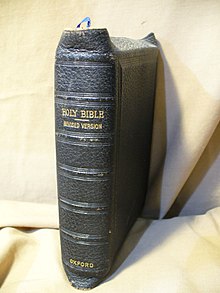
Outside cover of Revised Version of Bible, bound in leather with a full yapp, Published by Oxford in 1885.
Others looking at such loosely translated versions started to attack those translations and got the wheel going with lots of discussions saying this or that translation was a corrupted one. Also reasons for a new translation gave the impression to others that they should doubt the sincerity of the translation. as such Muslims got food to call the Bible corrupted, looking at sayings in prefaces, like the scholars’ introduction of the Revised Standard Version of The Bible produced in 1971 as proof of this. {Christian Scholars Admit To Corrupting The Bible} In the Preface are these words:
The King James Version has grave defects…these defects are so many and so serious as to call for revision.
Under The Milky Way writes
Muslims find these statements by Christian scholars to be self-incriminating. For Christian scholars to say that the King James Version of the Bible has grave defects which require revision is taken as a self-evident admission that either the Revised Standard Version (RSV) or the King James Version (KJV) of The Bible or both have been intentionally distorted with the intention of fabricating false teaching. {Christian Scholars Admit To Corrupting The Bible}
Though this translation was called to be the first and the only officially authorised and recognised revision of the King James Version in Britain, having the Old Testament edited four years later than the New Testament, which saw the light in 1881. The Apocrypha got printed in 1894. Brooke Foss Westcott and Fenton John Anthony Hort, whose texts formed also the basic for the New World Translation (NWT) where the best known of the translation committee members. Their stated aim was
“to adapt King James’ version to the present state of the English language without changing the idiom and vocabulary,”
and
“to adapt it to the present standard of Biblical scholarship.”
To those ends, the Greek text that was used to translate the New Testament was believed by most to be of higher reliability than the Textus Receptus used for the KJV. The readings used were compiled from a different text of the Greek Testament by Edwin Palmer. {Palmer, Edwin, ΚΑΙΝΗ ΔΙΑΘΗΚΗ. The Greek Testament] with the Readings Adopted by the Revisers of the Authorised Version. London: Simon Wallenberg Press, 2007. ISBN 1-84356-023-2}
This version was adapted and revised as the “Revised Version, Standard American Edition” or getting names as American Revised Version, the American Standard Revision, the American Standard Revised Bible, and the American Standard Edition, but at the end of the 20th century commonly known as the American Standard Version (ASV). Here-fore Philip Schaff had recruited scholars from different denominations (Baptist, Congregationalist, Dutch Reformed, Friends, Methodist, Episcopal, Presbyterian, Protestant Episcopal, and Unitarian) who began work in 1872 to complete it 29 years later.
The Revised Version (both the 1885 and the American Standard Version of 1901) are some of the Bible versions that are authorized to be used in services of the Episcopal Church, the Church of England and the Anglican Communion. For the American version was chosen to bring in again God’s Divine Name and where normally the tetragrammaton stood in the original text, it is consistently rendered Jehovah in 6,823 places of the ASV Old Testament, rather than YHWH or rather than LORD as it appears in the King James Bible.
That choice of omitting God’s Name would become more important in later years, several editors afraid of publishing God’s Holy Name and therefore preferring to print the ‘meaningless’ word ‘Lord’ (in later years even omitting the big capitals) so that people could not see the difference between the Lord Most High, the Adonai Elohim Hashem Jehovah, and God His son, the other lord between the many lords.
During the mid-20th century again a revision appeared on the market wanting
“to put the message of the Bible in simple, enduring words that are worthy to stand in the great Tyndale-King James tradition.”

Revised Standard Version
In a first stage a New Testament (first edition), 1946 (originally copyrighted to the International Council of Religious Education), six years later followed by the Old Testament and thus offering the full ‘Protestant Bible’. A Catholic version was accomplished with the Apocrypha in 1957. Again receiving some modification and a Modified edition (1962) followed by the RSV Catholic Edition (RSV-CE), (NT 1965, Complete Bible 1966). those editions got again revisions with publications in 1971, 1973, an Apocrypha expanded edition (1977) and a RSV Second Catholic (or Ignatius) Edition (RSV-2CE) in 2006.
In later years, the RSV served as the basis for two revisions – the New Revised Standard Version (NRSV) of 1989, using gender-neutral language, and the Protestant evangelical English Standard Version (ESV) of 2001.
A revision in 1973 ordered the books in a way that pleased both Catholics and Protestants, dividing the library into four sections:
- The Old Testament (39 Books)
- The Catholic Deuterocanonical Books (12 Books)
- The additional Eastern Orthodox Deuterocanonical Books (three Books; six Books after 1977)
- The New Testament (27 Books)
Four years later that ‘Common Bible’ got the Apocrypha expanded to include 3 Maccabees, 4 Maccabees, and Psalm 151, three additional sections accepted in the Eastern Orthodox canon (4 Maccabees again forming an appendix in that tradition), although it still does not include additional books in the Syriac and Ethiopian canons. This action increased the Common Bible to 84 Books, making it the most comprehensive English Bible translation to date with its inclusion of books not accepted by all denominations. The goal of the Common Bible was to help ecumenical relations among the churches.
Facing all those revisions of revisions this Summer the non-profit publisher Crossway released what they are describing as a “permanent” English biblical translation which has sought to be “as literal as possible” while maintaining clarity of expression and literary excellence, but still shall need some updating. But such updating sometimes can bring wrong texts.
17 years after it was first authorized by Crossway, its publisher, the translation oversight committee changed just 52 words across 29 verses — out of more than 775,000 words across more than 31,000 verses — for what they called the final “permanent text” edition. The board then voted, unanimously, to make the text “unchanged forever, in perpetuity.”
“The text of the ESV Bible will remain unchanged in all future editions printed and published by Crossway—in much the same way that the King James Version (KJV) has remained unchanged ever since the final KJV text was established almost 250 years ago (in 1769),”
Crossway stated on its website.
One difference: While the ESV copyright is held universally by Crossway, the KJV copyright held by the Crown of England is only valid in the United Kingdom. So modified versions of the KJV have been popping up in the United States and elsewhere for several hundred years. (Christian Today has explored whether copyrights help or hurt Bible translation.)
The publisher’s intended goal was
“to stabilize the [ESV], serving its readership by establishing the ESV as a translation that could be used ‘for generations to come,’”
The editor desires for
“there to be a stable and standard text that would serve the reading, memorizing, preaching, and liturgical needs of Christians worldwide from one generation to another.”
This September they wrote:
“Our goal at Crossway remains as strong as ever to serve future generations with a stable ESV text. But the means to that goal, we now see, is not to establish a permanent text but rather to allow for ongoing periodic updating of the text to reflect the realities of biblical scholarship such as textual discoveries or changes in English over time.”
That way the same will happen to the ESV as to the KJV that people are going to think they have it about the same Bible translation, though might have a totally different version.
What happened in the past is that many people each time a new revision came unto the market, certainly with a different name several Christians reacted strongly against the new text. Lots of church members prefer a text that doesn’t and won’t ever change, not a text that is on the path of continual improvement. This also comes mainly because several denominations stick to only one Bible translation and do not, like several non-trinitarian groups, have a roster of different Bible translations to look at, taking every time an other version as standard for the next year, having their members to think about the essence of the text and not pinpointing to human doctrinal teachings or limiting themselves just to one Bible version.
Tremper Longman III, a member of the New Living Translation (NLT) committee said
But making a translation permanent ignores the need for updates that reflect scholars’ advances in their understanding of the text, as well as the continuing development of English as a living language.
He continued
“Most translators and linguists would say that such an approach to translation is actually less accurate in terms of communicating the thought of the ancient writer to a modern audience.”
People should always remember that language is a living thing and by the years words may change meaning or additional (new) words may be better suited to bring over the meaning of those old writing, of which researchers still get more and new insights. Longman also remarks
“The English language changes, and my guess is that over the years even this particularly type of translation will sound more and more stilted, just as the KJV does to modern readers.”
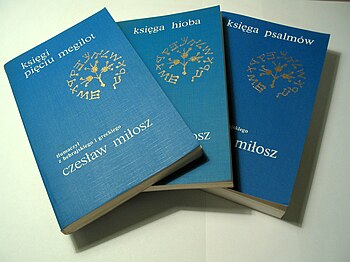
Bible translations to polish language by Czesław Miłosz. On the left Five Megillot, in center Book of Job, on right Psalms (Photo credit: Wikipedia)
Publishers are aware that the copyrights of a publication are limited in time and as such it is more profitable to create a whole new Bible version to keep the money coming into the till. At certain times there are also new preachers of high position who want to have their notes presented in a bible version they feel good with in a language of the time they are living in, what again demands a new Bible translation, under a new name.
+
Preceding articles:
Old and newer King James Versions and other translations #1 Pre King James Bible
Old and newer King James Versions and other translations #2 King James Bible versions
Old and newer King James Versions and other translations #3 Women and versions
Old and newer King James Versions and other translations #4 Steps to the women’s bibles
Old and newer King James Versions and other translations #5 Further steps to women’s bibles
++

Additional reading
- Absolute Basics to Reading the Bible
- Finding and Understanding Words and Meanings
- Lord in place of the divine name
- Lord or Yahuwah, Yeshua or Yahushua
- Lord and owner
- People Seeking for God 7 The Lord and lords
- Another way looking at a language #5 Aramic, Hebrew and Greek
- Another way looking at a language #6 Set apart
- Trusting, Faith, Calling and Ascribing to Jehovah #13 Prayer #11 Name to be set apart
- Thou shalt worship the Lord thy God
- The Bible and names in it
- Let us recognise how great God is
- Listening and Praying to the Father
- Written to recognise the Promissed One
- Holiness and expression of worship coming from inside
- Hashem השם, Hebrew for “the Name”
- Background to look at things
- Religious people and painful absence of spring of living water
- 2001 Translation an American English Bible
- NWT and what other scholars have to say to its critics
- Some Restored Name Versions
- The most important translation…
- Accuracy, Word-for-Word Translation Preferred by most Bible Readers
- Listening and Praying to the Father
+++

From Mary Harwell Sayler’s article Lent: Let the Bible readings begin!
Further related articles
- The inspiration of Scripture
- The Preservation of Scripture
- The Challenge of Translating
- English Bible Translations
- Infographic on English Bible Translations
- How Trustworthy Are Bible Translations?
- The most important translation…
- Advice for The Church (Part 3 – Translation)
- What Makes A Bible Translation Good?
- Where was the Bible before 1611? How can we know God endorsed the KJV?
- The King James Bible and the Restoration
- The King James Removed Verses?
- Study the Word for More Than Words
- The Bible or The Watchtower?
- What is the New World Translation?
- Brief Introduction to the Greek Text of the New Testament
- I believe the King James Bible is the final authority in all matters of faith and practice.
- King James Only?
- King James Only–Refuted
- Six Reasons To Not Follow “King James Version-onlyism”
- Textual Criticism Pt. 1
- Manuscripts in the Old Testament Synagogue
- Textual Criticism Pt. 1
- Which is the best English Bible?
- 128 Source Greek Text for NT Translation
- 133 Komma Johanneum in die King James Version.
- ESV Men’s Devotional Bible
- Top Five Premium ESV Bibles for Christmas 2015 (plus two)
- The English Standard Version of the Bible
- ESV Classic Reference Bible (ESV1) in Burgundy Goatskin by R. L. Allan & Son
- ESV Journaling Bible: Interleaved Edition in Natural Brown Cowhide
- ESV Heirloom Thinline Bible in Brown Calfskin (Crossway)
- Bible Reviewer: ESV Single Column Journaling Bible
- Crossway Reverses Decision to Make ESV Bible Text Permanent
- Does the ESV Honour the Holy Spirit?
- ESV for “Joe the Bus Driver”
- (Lost in) Permanent Translation
- Book Review, “Guys Slimline Holy Bible,” Tyndale House publishers
- Girls Slimline Holy Bible
- Sanctuary: A Devotional Bible for Women, New Living Translation
- Bible Review: Tyndale Select Reference Edition
- Neither Conservative or Liberal … Let’s Be Just!
- Lent: Let the Bible readings begin!
- Trinitarian Bible Society
- Was Dr. John R. Rice a Heretic?
- Straightway
- Applying God’s Holy Word
- How to Study Your Bible…a book review
- Basic Principles for “Doing Theology”
- Synod Dunnville 2016 (7)
+++
Related articles












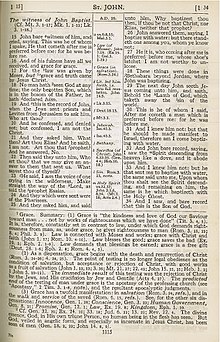
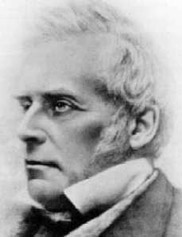
 It was after 25 years serious research that in 1881 the British bishop, biblical scholar and theologian, and
It was after 25 years serious research that in 1881 the British bishop, biblical scholar and theologian, and 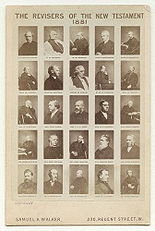












 Bijbelvorsers Webs
Bijbelvorsers Webs Belgische Vrije Christadelphians / Belgian Free Christadelphians – Old Google Main Website
Belgische Vrije Christadelphians / Belgian Free Christadelphians – Old Google Main Website Christadelphian Ecclesia
Christadelphian Ecclesia Hoop tot Leven – Redding in Christus
Hoop tot Leven – Redding in Christus
Old and newer King James Versions and other translations #7 Jewish versions
Leningrad Codex (cover page E, folio 474a)
The Leningrad Codex (Codex Leningradensis) or “L” is the oldest dated ms. of the complete Hebrew Bible, using the masoretic text and Tiberian vocalization. This earliest extant Hebrew Bible codex, Leningrad Codex or the Cairo Prophets was written and punctuated by Moses ben Asher in Tiberias (in Palestine) in 895. Next in age is the Leningrad Codex of the Latter Prophets dated to 916, which was not originally the work of Ben Asher, but its Babylonian pointing—i.e., vowel signs used for pronunciation purposes—was brought into line with the Tiberian Masoretic system.
Many wealthy Jews employed scribes to copy manuscripts in order to foster Bible study. When Abraham b. Ḥayyim di Tintori, a master craftsman had largely solved the problems of both vowel-points and accents it became easier to print Hebrew bibles.
Influenced of the Bibles and chronicles in rhyme produced by German writers from the ninth century onwards Yiddish bibles appeared in medieval times.
One of the most interesting rabbis of the Middle Ages, Rabbi Samuel (Shmu’el) son of (ben) Meir (Rashbam) of Northern France his writings were going to be used by many and it can be seen that many aspects of his Torah commentary seem similar to what we find in works of modern biblical scholarship.
For non Yiddish Jewish Bibles they first only saw prints in Hebrew, which started in a 1477 edition of the Psalms, with each verse followed by the appropriate passage from David Kimḥi‘s commentary, an arrangement which does not appear again in Hebrew Bibles. His dictionary of the Hebrew language called Sefer Hashorashim (Book of Roots) (ספר השורשים) draws heavily on the earlier works of Rabbi Judah ben David Hayyuj and Rabbi Jonah ibn Janah, as well as from the work of his father the grammarian, exegete, poet, and translator Rabbi Joseph Kimhi.
The first Great Rabbinic Bible, edited by Felix Pratensis, who was born a Jew but was baptized in 1506, was published in 1516–17.
From the early 18th century, progressive anglicization of Jewish settlers in England and America rendered first the Spanish, and ultimately the Yiddish, translations inadequate for educational needs. The King James Version became current in spite of the Christianizing tendency of some of its “headlines” to the Prophets. The Pentateuch with haftarot published in London by David Levi (1787) appears to be the King James Version but without offending captions and with Jewish annotations. An earlier Pentateuch was produced by A. Alexander in 1785.
Portrait of Seligman Baer, from the 1906 Jewish Encyclopedia.
The masoretic scholar Seligmann Baer, published an Hebrew Bible in single volumes with notes, except for Exodus to Deuteronomy, strictly following the Masoretic tradition. The volumes, with a Latin preface by Franz Delitzsch, appeared (Leipsic, Tauchnitz) in the following order: Genesis, 1869; Isaiah, 1872; Job, 1875; Minor Prophets, 1878; Psalms (together with a treatise “Elementa Accentuationis Metricæ”), 1880; Proverbs (together with “De Primorum Vocabulorum Dagessatione”), 1880; Daniel, Ezra, and Nehemiah (together with “Chaldaismi Biblici Adumbratio” and a treatise by Friedrich Delitzsch (son of Franz Delitzsch) on the Babylonian proper names in these books), were published in 1882; Ezekiel (with “Specimen Glossarii Ezechielico-Babylonici” by Friedrich Delitzsch), appeared in 1884; followed by the five Megillot, 1886; the book of Chronicles, 1888; Jeremiah, 1890; Joshua and Judges, 1891; and finally Kings, 1895. The last two were edited by Baer alone, Delitzsch having died in 1890.
Death prevented Baer from finishing the series. Attached to each volume were a number of Masoretic notes taken from the best editions and manuscripts, variant readings between the Occidentals and Orientals, between Ben Asher and Ben Naphtali, and various other Masoretic lists and enumerations.
The most comprehensive Polyglot Hebrew Bibles are Brian Walton‘s London Polyglot (1654–57) which contained texts in Hebrew, Samaritan, Aramaic, Greek, Latin, Ethiopic, Syriac, Arabic, and Persian (all with Latin translations), and Samuel Bagster‘s Polyglot (1831) in Hebrew, Greek, Samaritan, Latin, Syriac, German, Italian, French, English, and Spanish. More modern polyglots have contented themselves with giving the texts in Hebrew, Greek, Latin, and a modern language.
Isaac Leeser
This got him to present first the Pentateuch, Torat ha-Elohim (“The Torah of God”) in 1845 and then eight years later, adhering to the same Masoretic text that was used by the King James translators, he offered “The Twenty-four Books of the Holy Scriptures: Carefully Translated According to the Massoretic Text, On the Basis of the English Version, After the Best Jewish Authorities; and supplied with short explanatory notes. By Isaac Leeser. ” in Philadelphia, 1853. His complete Old Testament in English (1853) incorporated matter from the Mendelssohn school’s German translation and included the Hebrew text.
Criticism was that to much of the Teutonic protruded in the translation. His English being very Germanic, with long and complex sentences, but still the language of America.
This English Bible revision could be called “Jewish” in that it eliminates a few renderings that Jews have associated with Christianity (such as “virgin” in Isaiah 7:14 “young girl”), and also by virtue of its religious adherence to the traditional Hebrew text. Incorporating rabbinic readings of the Bible into his text via parentheses Leeser’s version stood as pre-eminent in the American Jewish community until the appearance of the “Old JPS” translation of 1917.
Leeser also believed in speaking to women, inspiring them, caring for their religious well-being. He wrote in The Occident:
After his death, Leeser’s publishing enterprise became the Jewish Publication Society, which still operates today. He was the forerunner of Artscroll, Koren and all the successful Orthodox publishers.
At the other site of the ocean in Great Britain Abraham Benisch the Bohemian journalist and theologian in pursuance of his mission, had came to London, where he devoted himself to Jewish journalism and literature, and acquired considerable influence in Jewish and Christian circles. he helped founding the Biblical Institute and its allies, The Syro-Egyptian and The Biblical Chronological societies. These three were afterwards fused into the Society of Biblical Archaeology. From from 1851 to 1861 in four sequential volumes he published A Translation of the Tanakh, Published with the Hebrew Text.
In 1896 C.G. Montefiore’s Bible for Home Reading was published.
Michael Friedländer best known for his English translation from the original Arabic text of Maimonides’ Guide to the Perplexed.
Similar in style to the King James Version English Jewish people could find a Jewish Family Bible in English and Hebrew, edited by the orientalist and principal of Jews’ College, London, Michael Friedländer (1881).
After the Revised Version of 1885 had appeared, the London Jewish Religious Education Board published (1896) a pamphlet listing essential emendations to make that version acceptable for Jewish use. These modifications were among the material utilized for the version published by the Jewish Publication Society of America in 1917, which also took into account 19th-century Jewish Bible scholarship and rabbinical commentary (e.g., Malbim); the edition – issued by a committee representative of both traditional and Reform Judaism – was basically the work of Max L. Margolis.
The Central Conference of American Rabbis, the organization of Reform rabbis in 1892 brought a project to bring the first translation for which a group representing Jewish learning among English-speaking Jews assumed joint responsibility, but each person would take up a book to translate. Assigning different books of the Bible to individual rabbis and scholars did not look the ideal way to have a good progress. After more than a decade only the Book of Psalms had been sent to press. In 1908 the Jewish Publication Society of America agreed to take over the project. Under the direction of Editor-in-Chief Max Margolis, the editors included Solomon Schechter, Cyrus Adler, Joseph Jacobs, and faculty members of Hebrew Union College (associated with Reform Judaism), the Jewish Theological Seminary (part of the Conservative Judaism movement), and Dropsie College (a graduate school not affiliated with any movement).
They continued working on a version which essentially retained the Elizabethan diction. It stuck unswervingly to the received Hebrew text that it interpreted in accordance with Jewish tradition and the best scholarship of the day. For over half a century it remained authoritative, even though it laid no claim to any official ecclesiastical sanction.
The 1917 JPS translation.
The translation, which appeared in 1917, with the full publication title The Holy Scriptures According to the Masoretic Text: A New Translation with the Aid of Previous Versions and with Constant Consultation of Jewish Authorities, follows the edition of Seligman Baer except for the books of Exodus to Deuteronomy, which never appeared in Baer’s edition and for which C. D. Ginsburg‘s Hebrew text was used. It is heavily indebted to the Revised Version and American Standard Version.
The 1917 version is still widely disseminated through its appearance in the commentaries of the Soncino Books of the Bible, a set of Hebrew Bible commentaries, covering the whole Tanakh (Old Testament) in fourteen volumes, and the Torah commentary edited by Joseph H. Hertz. Further, it has influenced many subsequent 20th century translations by drawing attention to the Jewish view of many passages.
U.S. Jewish Zionist leader and founder of Hadassah, the Women’s Zionist Organization of America Henrietta Szold
In 1955 a renewed look at the Holy Scriptures from the Jewish view and tradition was taken. Reform Rabbi Joseph Krauskopf as a non-profit publisher got the daughter of the German-speaking Hungarian immigrant family of rabbi Benjamin Szold, Henrietta Szold (1860–1945), to become the responsible for the publication of the English version of Judaic works and for a contemporary translation in English of the Tanakh. The Jewish Publication Society of America wanted some new or more up-to date language and assembled a committee of translators composed of three professional biblical and Semitic scholars and three rabbis. In 1962 they presented the Pentateuch and seven years later The Song of Songs, Ruth, Lamentations, Ecclesiastes, Esther, and Jonah, where offered all in a single volume for the convenience of synagogue use. It took until 1973 to have the appearance of Isaiah and Psalms.
Language evolving the Jewish community found the revision of the outdated 1917 version New Bible Translation in English for the Jewish People of 1953/1955-1962 also to obsolete and worked on a new version resulting in the “New JPS version“, abbreviated NJPS (it has also been called the “New Jewish Version” or NJV).
Harry M. Orlinsky (1908–1992) editor-in-chief of the New Jewish Publication Society (NJPS) translation of the Torah (1962)
Harry M. Orlinsky, Professor of Bible at Hebrew Union College — Jewish Institute of Religion (New York), was asked to serve as editor-in-chief for the new translation, along with H. L. Ginsberg, Professor of Bible at the Jewish Theological Seminary, and Ephraim A. Speiser, Professor of Semitic and Oriental Languages at the University of Pennsylvania, as fellow editors. Associated with them were three rabbis: Max Arzt, Bernard J. Bamberger, and Harry Freedman, representing the Conservative, Reform, and Orthodox branches of organized Jewish religious life. Solomon Grayzel, editor of the Jewish Publication Society, served as secretary of the committee.
Together they created a gender-free translation of the Bible. He also had helped the Protestant National Council with their Revised Standard Version (RSV) of the Bible and then again with the New Revised Standard Version (1989). He was also instrumental in helping to get The Prophets (Nevi’im) (1978) and The Writings (Kethuvim)(1982) published as well.
A number of the changes for the 1985 version had already been projected in Notes on the New Translation of the Torah, edited by Harry M. Orlinsky and published by the Society in 1969 and in the publication of The Book of Job, in 1980. Subsequent research on the text has led to further revisions in the translation of Torah and some revisions in Nevi’im as well.
Afterwards four outstanding Torah scholars (Nahum M. Sarna, Baruch A. Levine, Jacob Milgrom and Jeffrey H. Tigay) with the JPS Torah Commentary series wanted to represent a fusion of the best of the old and new. Utilizing the latest research to enhance their understanding of the biblical text, it came to take its place as one of the most authoritative yet accessible Bible commentaries of our day.
In 1936 “The Holy Scriptures” was published and revised in 1951, by the Hebrew Publishing Company, revised by Alexander Harkavy. In this Hebrew Bible translation in English the Tetragrammaton is presented by the Divine Name of God which is very unusual for a Jewish Bible. Perhaps this accounts for it not gaining the popularity of the JPS Tanakh.
The 1973 edition of the New Oxford Annotated Bible, with the RSV text
In 1962 in-depth academic research from non-denominational perspectives, specifically secular perspectives for “Bible-as-literature” with a focus on the most recent advances in historical criticism and related disciplines, with contributors from mainline Protestant, Roman Catholic, Jewish, and non-religious interpretative traditions, brought a Bible translation that could be used by any Christian or Jewish group. Edited by Herbert G. May and Bruce Metzger, the Oxford Annotated Bible (OAB) study Bible got published by the Oxford University Press (OUP) receiving a a matching edition of the apocryphal books as well as a version of the OAB including them in 1965.
Based on the Revised Standard Version (RSV) of the Bible it was renewed and published in 1973 under the name New Oxford Annotated Bible (NOAB) which got revisions based on the New Revised Standard Version (NRSV) of the Bible of 1989 and got a more ecumenical version in 2000 .
The New Oxford Annotated Bible with Apocrypha: New Revised Standard Version 4th ed. Edition
The New Oxford Annotated Bible with Apocrypha offers a vast range of information, including extensive notes by experts in their fields; in-text maps, charts, and diagrams; supplementary essays on translation, biblical interpretation, cultural and historical background, and other general topics.
Knesset Speaker Kadish Luz announced in 1965 that
The Bible Society in Israel derived from a phrase in the Book of Jeremiah, in the Hebrew Bible the name Habrit Hakhadasha/Haderekh ( ‘the road’ or the New Covenant) for its paraphrased bible (1976, revised 1991). It uses more basic vocabulary and literary style than does Delitzsch, and is similar to English versions such as the 1966 Good News Bible (GNB), also called the Good News Translation (GNT) in the United States or the Kenneth N. Taylor paraphrasings of 1962 New testament Living Letters and the 1971 “A Thought-For-Thought Translation” The Living Bible (TLB). The Living Bible being the best-selling book in America we can imagine that the Jewish community also wanted a similar Jewish bible.
ArtScroll Tanach Series presenting the comments of the classic giants of ancient and contemporary times in a logical, comprehensible manner, like a master teach on an exciting voyage of intellectual discovery.
In 1981 Moznaim Publishing The Living Torah by the American Orthodox rabbi and author known for his knowledge of physics and kabbalah, Aryeh Kaplan offered an Orthodox translation into contemporary English. He includes the rabbinic elucidation of the text, which he consciously interspersed with later rabbinic commentary and Jewish law. It was reissued in a Hebrew-English version with haftarot for synagogue use. After Kaplan’s death in 1983, The Living Nach was translated in the same style by Yaakov Elman for Nevi’im (two volumes: “The Early Prophets” and “The Latter Prophets”) and Ketuvim (“Sacred Writings” in one volume) by Moshe Schapiro, M.H. Mykoff (Breslov Research Institute), and Gavriel Rubin.
Inspired by the German translation prepared by the Austrian-born Israeli Jewish philosopher, honorary professor at the University of Frankfurt am Main, Martin Buber and the German Jewish theologian, philosopher, and translator Franz Rosenzweig, Everett Fox translated the Torah (The Five Books of Moses, 1995) for Schocken Press. It uses hyphenated phrases and is printed in blank verse, and the personal and place names are transliterated versions of the Hebrew names.
In 2005 appeared Jay P. Green’s The Interlinear Bible: Hebrew-Greek-English (Peabody, Mass.: Hendrickson Publishers) based on the Masoretic text. The words are keyed to Strong’s Exhaustive Concordance. The print is much smaller than John R. Kohlenberger III, Interlinear NIV Hebrew-English Old Testament (based on the Hebrew text of BHS and the NIV) But the Green translation does seem not as accurate. Volume also contains a Linear Greek New Testament.
Rudolf Kittel’s Biblia Hebraica, the Dead Sea Scrolls and the Biblia Hebraica Stuttgartensia were used as a basic for several Jewish translations and also used for the 1995 revision of the American Bible, maintaining a word-for-word translation style, presented by the Lockman Foundation as the New American Standard Bible, which is widely regarded as the most literally translated of major 20th-century English Bible translations. A committee consisted of people from many Protestant, predominantly conservative, denominations, Presbyterian, Methodist, Southern Baptist, Church of Christ, Nazarene, American Baptist, Fundamentalist, Conservative Baptist, Free Methodist, Congregational, Disciples of Christ, Evangelical Free, Independent Baptist, Independent Mennonite, Assembly of God, North American Baptist, and “other religious groups” prepared the original work (1963-1971) and more than 20 individuals worked on modernizing the NASB in accord with the most recent research, supplanting the 1977 text in current printings, save for a few (Thompson Chain Reference Bibles, Open Bibles, Key Word Study Bibles, et al.) It got further revisions from 1992 up to 1995.
Early this century Robert Alter translated the Torah in The Five Books of Moses (2004) and in a Chasidism translation created the Gutnick Edition of the Chumash (2006).
16th-century depiction of the French religious scholar Rashi, acronym of Rabbi Shlomo Yitzḥaqi (1040-1105) renowned medieval French commentator on the Bible and the Talmud
Judaica Press, an Orthodox Jewish publisher, has published a multi-volume bilingual Hebrew–English translation of the Bible that includes the medieval French rabbi Rashi‘s comprehensive commentary on the Talmud and commentary on the Tanakh in both Hebrew and English, Complete Tanach with Rashi.
The Jewish Annotated New Testament, Edited by Amy-Jill Levine and Marc Z. Brettler
In 2011 University Professor of New Testament and Jewish Studies Amy-Jill Levine, E. Rhodes and Leona B. Carpenter Professor of New Testament Studies, Vanderbilt Divinity School, and Marc Z. Brettler, Dora Golding Professor of Biblical Studies, Brandeis University, edited The Jewish Annotated New Testament. It brings out Jewish background of early Christianity, New Testament writers and can be very helpful for non-Jewish readers interested in the Jewish roots of Christianity, also making it clear where certain Christians went wrong in their thinking because of their insufficient knowledge of Jewish way of speaking and thinking. The book also explains Jewish concepts (e.g., food laws, rabbinic argumentation) for non-Jews, Christian concepts (e.g., Eucharist) for Jews.
***
***
***
*
Please find to read
+
Preceding articles:
Old and newer King James Versions and other translations #1 Pre King James Bible
Old and newer King James Versions and other translations #2 King James Bible versions
Old and newer King James Versions and other translations #3 Women and versions
Old and newer King James Versions and other translations #4 Steps to the women’s bibles
Old and newer King James Versions and other translations #5 Further steps to women’s bibles
Old and newer King James Versions and other translations #6 Revisions of revisions
++
Additional reading
+++
Further reading
+++
Related articles
Related articles
Rate this:
Share this:
Category:
Bible study, History, Religion, Video, Word of God
Tagged with: